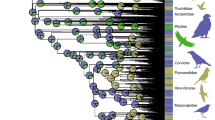Abstract
Flightlessness has evolved independently in at least 11 extant avian families. A number of hypotheses have been proposed to explain these transitions in individual families, including release from predation on oceanic islands, energetic costs of flight and use of forelimbs for activities other than flying. Few studies have sought to explore factors common to all families containing flightless species, which may explain the taxonomic distribution of flightlessness. In this study, we found that for all eight avian families which contain both flightless and flighted species, the flighted species have shorter wing lengths relative to body mass than their sister families. This result is not biased by taxon size. Models of avian aerodynamics predict that birds with relatively short wings pay a high energetic cost of flight. We suggest that these increased energetic costs of flying predispose these avian families to evolve flightless species. The various causes for the shortening of wings among flighted species of birds and the possibility of future transitions to flightlessness are discussed.
Similar content being viewed by others
References
Bennett, P.M. (1986) Comparative studies of morphology life history and ecology among birds. Unpublished thesis, University of Sussex.
Diamond, J.M. (1991) A new species of rail from the Solomon Islands and convergent evolution of insular flightlessness. The Auk 108, 461-470.
Dunning, J.B. (1993) CRC Handbook of Avian Body Masses. CRC Press, Boca Raton, FL.
Feduccia, J.A. (1980) The Age of Birds. Harvard University Press, Cambridge, MA.
Felsenstein, J. (1985) Phylogenies and the comparative method. Am. Nat. 125, 1-15.
Harvey, P.H. (1991) Comparing uncertain relationships: The Swedes in revolt. TREE 6, 38-39.
Harvey, P.H. and Pagel, M.D. (1991) The Comparative Method in Evolutionary Biology, pp. 186-196. Oxford University Press, Oxford.
Hedenstrom, A. and Moller, A.P. (1992) Morphological adaptations to song flight in passerine birds: A comparative study. Proc. R. Soc. Lond. B 247, 183-187.
Livezey, B.C. (1988) Morphometrics of flightlessness in the Alcidae. The Auk 105, 681-698.
Livezey, B.C. (1989a) Flightlessness in grebes (Aves: Podicipedidae): Its independent evolution in three genera. Evolution 43, 29-54.
Livezey, B.C. (1989b) Phylogentic relationships and incipient flightlessness of the extinct Auckland Islands merganser. Wilson Bull. 101, 410-435.
Livezey, B.C. (1992) Flightlessness in the Galapagos cormorant (Compsohalieus [Nannopterum] Harrisi): Heterochrony, giantism and specialization. Zool. J. Linn. Soc. 105, 155-224.
Livezey, B.C. (1993) An ecomorphological review of the dodo (Raphus cucullatus) and solitaire (Pezophaps solitaria), flightless Columbiformes of the Mascarene Islands. J. Zool. Lond. 230, 247-292.
Livezey, B.C. and Humphrey, P.S. (1986) Flightlessness in Steamer ducks (Anatidae: Tachyeres): Its mor-phological bases and probable evolution. Evolution 40, 540-558.
McNab, B.K. (1994a) Energy conservation and the evolution of flightlessness in birds. Am. Nat. 144, 628-642.
McNab, B.K. (1994b) Resource use and the survival of land and freshwater vertebrates on oceanic islands. Am. Nat. 144, 643-660.
Mooers, A.O. and Cotgreave, P. (1994) Sibley & Ahlquist's tapestry dusted off. TREE 9, 458-459.
Olson, S.L. (1973) Evolution of the rails of the South Atlantic islands (Aves: Rallidae). Smithsonian Contrib. Zool. 152, 1-53.
Pennycuick, C.J. (1989) Bird Flight Performance - A Practical Calculation Manual. Oxford University Press, Oxford.
Purvis, A. and Rambaut, A. (1995) Comparative analysis by independent contrasts (CAIC): An Apple Macintosh application for analysing comparative data. Computer Appl. Biosci. 11, 247-251.
Roff, D.A. (1994) The evolution of flightlessness: Is history important? Evol. Ecol. 8, 639-657.
Sibley, C.G. and Ahlquist, J.E. (1990) Phylogeny and Classification of Birds: A Study in Molecular Evolution. Yale University Press, New Haven, CT.
Springer, M. and Krajewski, C. (1989) DNA hybridisation in animal taxonomy: A critique from first principles. Quart. Rev. Biol. 64, 291-318.
Wallace, A.R. (1880) Island Life. Macmillan, London.
Author information
Authors and Affiliations
Rights and permissions
About this article
Cite this article
McCALL, R.a., Nee, S. & Harvey, P.H. The role of wing length in the evolution of avian flightlessness. Evolutionary Ecology 12, 569–580 (1998). https://doi.org/10.1023/A:1006508826501
Issue Date:
DOI: https://doi.org/10.1023/A:1006508826501




